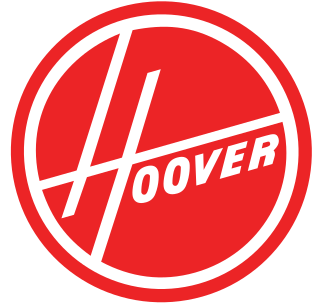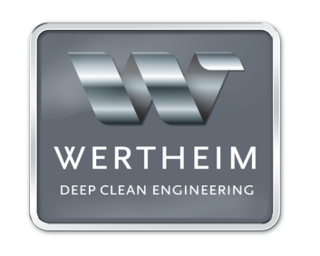
A vacuum cleaner, also known as a sweeper or hoover, is a device that uses an air pump, to create a partial vacuum to suck up dust and dirt from floors and from other surfaces such as upholstery and draperies.

Hoover is a vacuum cleaner company founded in Ohio in the US. It also established a major base in the United Kingdom and mostly in the 20th century it dominated the electric vacuum cleaner industry, to the point where the Hoover brand name became synonymous with vacuum cleaners and vacuuming in the United Kingdom and Ireland. Hoover was part of the Whirlpool Corporation but was sold in 2006 to Techtronic Industries for $107 million. Hoover Europe/UK split from Hoover US in 1993 and was acquired by Techtronic Industries, a company based in Hong Kong.

Dyson Ltd is a British technology company established in the United Kingdom by Sir James Dyson in 1991. It designs and manufactures household appliances such as vacuum cleaners, air purifiers, hand dryers, bladeless fans, heaters and hair dryers. As of February 2018, Dyson had more than 12,000 employees worldwide. In January 2019 it was announced that Dyson would move its headquarters to Singapore to ramp up manufacturing for their electric vehicle, stating Asia trade will be their main focus and commenting that the company was unhappy with EU/UK bureaucratic restrictions.
Lilla Essingen is a small island in central Stockholm, Sweden, next to the larger neighbouring island Stora Essingen.
Arçelik A.Ş. is a household appliances manufacturer from Turkey. The Company engages in the production and marketing of durable goods, components, consumer electronics and after-sale services. Its products include white goods, electronic products, small home appliances and kitchen accessories, such as refrigerators, freezers, washing machines, dishwashers, aspirators, vacuum cleaners, coffee makers and blenders.

The Electrolux Trilobite is a robotic vacuum cleaner manufactured by the Swedish corporation Electrolux. It takes its name from the extinct arthropod, which scoured the ocean's floor. The prototype cleaner was first seen on the BBC television programme, Tomorrow's World, in May 1996, when it was demonstrated by presenter Philippa Forrester. It was the world's first commercially available autonomous vacuum cleaner, introduced as a product in 2001, model ZA1. A revision was released as Version 2.0 in 2004, model ZA2.
Goblin Vacuum Cleaners was a British brand of vacuum cleaners made from the early 1900s till the early 2000s.

Aerus LLC, formerly Electrolux Corp. USA, manufactures vacuum cleaners, and air purifiers. It is headquartered in Dallas, Texas, and has over 500 independently owned franchises in the U.S. and Canada. Aerus is the successor to Electrolux USA, the iconic manufacturer of vacuum cleaners. However, the Electrolux name is now used in the U.S. by the Electrolux Group of Sweden, which until 2016 also manufactured Eureka vacuum cleaners.
Eureka is a brand of Midea Group that manufactures vacuums for all households. The company offers a full line of vacuum cleaners, including uprights, cordless, canisters, sticks and handhelds. Eureka also manufactures aftermarket vacuum accessories, such as bags, belts and filters.
The ornate sleeper-ray is a species of electric ray in the family Narkidae, and the only member of the genus Electrolux. It lives on reefs feeding on polychaete worms and small crustaceans, it has only been seen by divers to feed during the daytime. It is endemic to the coast of South Africa. It was first recorded in 1984 but was not described until 2007. It was ranked as the number one newly described species of 2007 by the International Institute for Species Exploration.

Wertheim is a brand of domestic vacuum cleaners and floor care products.
A hypoallergenic vacuum cleaner is a vacuum cleaner with filters designed to retain the vast majority of particles within the vacuum system.
If successful this retention would greatly reduce the amount of potential allergens in the environment in which it is used.
Regular vacuum cleaners are unable to retain most very fine dust and many allergens which simply are too small for the system to trap and are released from the system along with the exhaust air.

A robotic vacuum cleaner, often called a robovac, is an autonomous robotic vacuum cleaner which has intelligent programming and a limited vacuum cleaning system. The original design included manual operation via remote control and a "self-drive" mode which allowed the machine to clean autonomously without human control. Some designs use spinning brushes to reach tight corners. Others include a number of cleaning features along with the vacuuming.
Hans Straberg is the Chairman of Atlas Copco. He was the President & CEO of Electrolux AB from 2002 to 2010. Straberg is also a Bilderberg participant.
Kenmore is a brand of household appliances sold by Sears. The brand is owned by KCD IP LLC, a special purpose entity created by Sears Holdings for securitization purposes.

Stark's Vacuum Museum, also known as Stark's Vacuum Cleaner Museum, is a vacuum cleaner museum in Portland, Oregon. It showcases more than 100 vacuums from the late-1800s to the 1960s within a 10 feet (3.0 m) x 40-foot (12 m) section of the Stark's Vacuums store. Admission is free. Pieces include a 1930s cardboard model, a Duntley Pneumatic that attaches to the ceiling, an Electrolux on runners, and hand-pumped vacs.
A trilobite is a type of extinct marine arthropod.
A self-cleaning floor is a floor surface that reduces the amount of chemicals, energy, and human resources associated with cleaning floor surfaces. Such floors are meant for use in hospitals, toilets and other places in which cleanliness is of vital importance. In Europe, most of the leading ceramic tiles and sanitary ware manufacturers have products on the market with self cleaning features.







